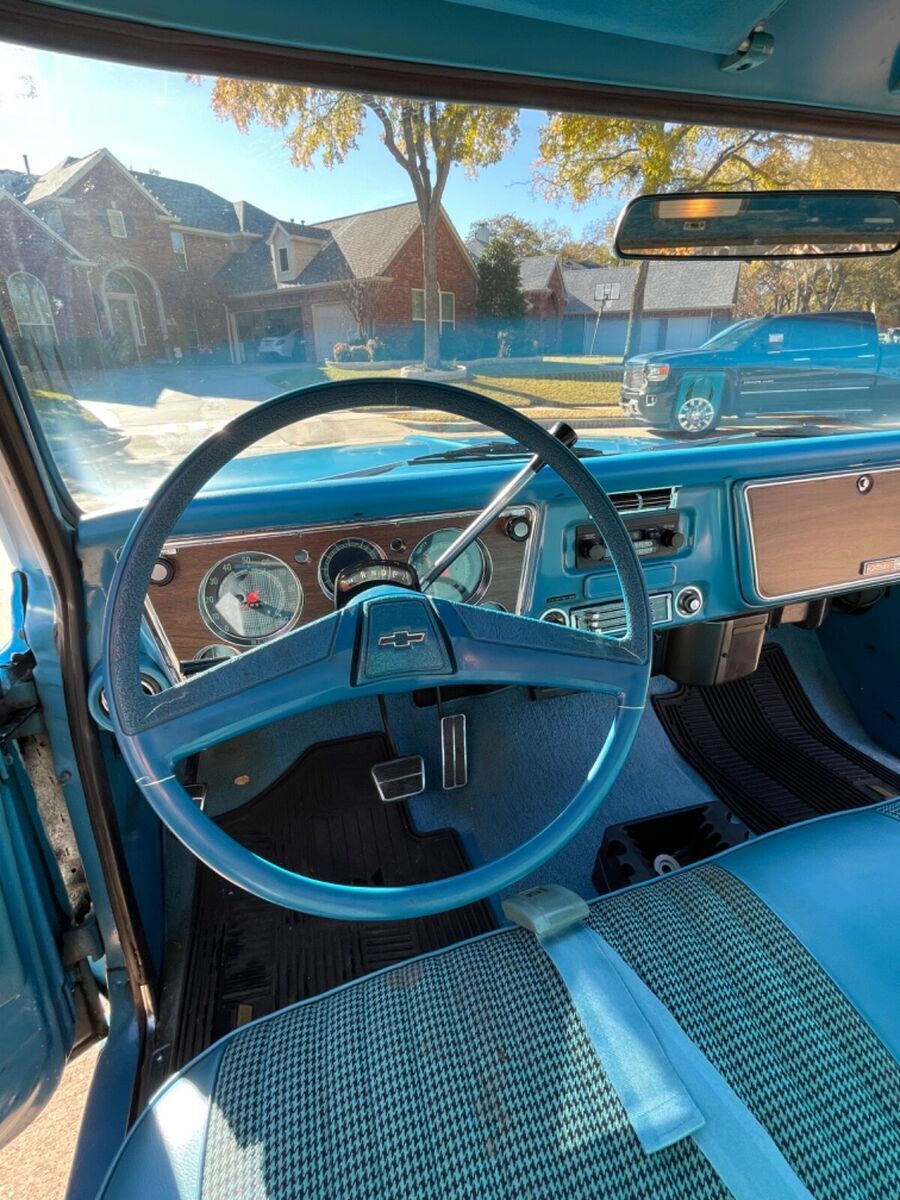1972 Chevy 4×4 Pickup Trucks For Sale: Your Ultimate Buyer’s Guide pickup.truckstrend.com
The year 1972 holds a special place in the hearts of classic truck enthusiasts, particularly when it comes to the venerable Chevrolet 4×4 pickup. Representing the final iteration of the iconic "Action Line" generation (1967-1972), the 1972 Chevy 4×4 is more than just a vehicle; it’s a rugged piece of American automotive history, a symbol of durability, and a canvas for customization. With its distinctive grille, timeless lines, and robust engineering, these trucks continue to command significant attention in the classic vehicle market. For anyone looking to own a piece of this legacy, navigating the world of 1972 Chevy 4×4 pickup trucks for sale requires knowledge, patience, and a keen eye. This comprehensive guide will arm you with the insights needed to find, evaluate, and acquire your dream vintage Bowtie truck.
The Enduring Appeal of the 1972 Chevy 4×4
1972 Chevy 4×4 Pickup Trucks For Sale: Your Ultimate Buyer’s Guide
What makes the 1972 Chevy 4×4 so highly sought after? Several factors contribute to its legendary status. Aesthetically, the ’72 model retains the clean, muscular lines of its predecessors, but with unique styling cues like the egg-crate grille with horizontal bars and the final year of the recessed taillights. This generation, particularly the 4×4 (K-series), was built for work and play, featuring heavy-duty components designed to withstand the rigors of off-road use and demanding tasks.
Under the hood, common engine options included the venerable 350 cubic-inch (5.7L) small-block V8, known for its reliability and ample torque, and occasionally the larger 400 cubic-inch V8. These were typically paired with durable manual transmissions like the SM465 "granny low" 4-speed or the automatic TH350 or TH400, feeding power to a robust New Process NP205 transfer case – a gear-driven unit celebrated for its bulletproof reliability. The solid front axle (Dana 44 or GM 10-bolt) and rear axle (GM 12-bolt) further cemented its reputation as an unstoppable force. The combination of timeless design, proven mechanicals, and genuine utility ensures the 1972 Chevy 4×4 remains a cherished classic that continues to appreciate in value.
Understanding the Market: What to Expect When Buying
The market for 1972 Chevy 4x4s is diverse, with prices varying wildly based on condition, originality, and configuration. It’s crucial to understand the different categories of trucks you’ll encounter:
- Project Trucks: These are typically non-running or require extensive restoration. Expect significant rust, mechanical issues, and missing parts. They are the most affordable but demand the most time, money, and expertise.
- Driver Quality Trucks: These are running and driving vehicles, often with some patina, minor rust, or cosmetic flaws. They are suitable for immediate enjoyment but may require ongoing maintenance and eventual repairs.
- Restored Trucks: These vehicles have undergone varying degrees of restoration, from frame-off rebuilds to cosmetic refreshes. Quality can range from good to excellent, reflected in the price.
- Show Quality/Concours Trucks: These are meticulously restored to original specifications or beyond, often commanding top dollar. They are typically trailered to shows rather than driven frequently.
- Restomods: A popular category where classic aesthetics meet modern performance. These trucks might feature updated powertrains (LS swaps), modern suspensions, air conditioning, and luxurious interiors. Their value is highly dependent on the quality of the modifications and components used.

Pricing Factors: Beyond condition, several elements influence a truck’s value:
- Body Style: Short bed/regular cab K10s are generally more desirable and command higher prices than long bed versions or C20/C30 heavy-duty models. Crew cabs are extremely rare and highly prized.
- Originality: Numbers-matching engines and original components can add significant value for purists.
- Options: Factory options like air conditioning, power windows, power locks, and specific trim packages (e.g., Cheyenne, Custom Deluxe) can increase desirability.
- Rust: The biggest enemy of these trucks. Extensive rust in critical areas (cab corners, rocker panels, floor pans, frame rails) can significantly devalue a truck.


Where to Find Your 1972 Chevy 4×4
Finding the right 1972 Chevy 4×4 requires a multi-pronged approach:
- Online Marketplaces:
- Bring a Trailer (BaT): High-end, curated auctions often feature meticulously restored or well-preserved examples.
- eBay Motors & ClassicCars.com: Broad selection ranging from projects to show vehicles.
- Hemmings Motor News: A long-standing resource for classic car sales.
- Facebook Marketplace & Dedicated Facebook Groups: Excellent for finding local listings and connecting with enthusiasts. Many groups are dedicated specifically to 67-72 Chevy trucks.
- Specialized Forums and Clubs: Online forums (e.g., 67-72chevytrucks.com) and local classic truck clubs often have classifieds sections where members sell their vehicles.
- Classic Car Dealerships: Reputable dealerships specializing in classics often have a selection of well-vetted and sometimes restored trucks, though typically at a premium.
- Auctions: Live auctions (e.g., Barrett-Jackson, Mecum) feature high-value, top-tier trucks. Local and online estate auctions can sometimes uncover hidden gems.
- Word of Mouth: Let friends, family, and mechanics know you’re looking. You might stumble upon a truck that hasn’t hit the public market yet.
The Inspection Process: A Buyer’s Checklist
Once you’ve found a potential candidate, a thorough inspection is paramount. If you’re not mechanically inclined, hire a trusted classic car mechanic for a pre-purchase inspection (PPI).
- Body and Frame:
- Rust Hotspots: Carefully inspect cab corners, rocker panels, floor pans, inner and outer fenders, bed floor, tailgate, and the frame rails. Pay attention to any bubbling paint, which indicates underlying rust.
- Panel Alignment: Check for consistent gaps between body panels, which can indicate previous accident damage or poor bodywork.
- Paint Condition: Look for overspray, mismatched colors, or signs of quick cover-ups.
- Engine and Drivetrain:
- Cold Start: Listen for strange noises (knocks, ticks), smoke from the exhaust (blue for oil, white for coolant), and check for leaks.
- Transmission: Test all gears, ensuring smooth shifts (manual or automatic). For manuals, check clutch engagement.
- Transfer Case: Engage 4-high and 4-low. Listen for grinding or clunking noises.
- Axles: Check for leaks around differentials and axle seals.
- Suspension and Steering:
- Inspect leaf springs, shocks, bushings, and tie rods for wear.
- Check for excessive play in the steering wheel.
- Interior:
- Examine seat upholstery, dashboard condition, headliner, and door panels.
- Test all gauges, lights, wipers, horn, and heater/AC (if equipped).
- Documentation:
- Verify the VIN matches the title.
- Ask for service records, previous registration, or any build sheets.
- Ensure the title is clear and transferable.
- Test Drive:
- Listen for unusual noises (clunks, squeaks, grinding).
- Feel for vibrations, pulling to one side, or spongy brakes.
- Test acceleration, braking, and steering response at various speeds.
- Engage 4×4 in a safe area to ensure it functions correctly.
Restoration vs. Preservation vs. Customization
Deciding what you want to do with your 1972 Chevy 4×4 is a crucial part of the buying process:
- Restoration: For purists, bringing a truck back to factory specifications is the goal. This often involves a full frame-off restoration, meticulous attention to detail, and sourcing period-correct parts. It’s expensive and time-consuming but can yield a highly valuable and authentic vehicle.
- Preservation: This approach focuses on maintaining the truck’s original condition, embracing its patina, and performing only necessary repairs to keep it roadworthy. It’s less intrusive and allows the truck’s history to shine through.
- Customization (Restomod): This is increasingly popular, blending classic looks with modern comfort, safety, and performance. Common modifications include engine swaps (e.g., GM LS engines), upgraded suspension (coil-overs, independent front suspension), disc brakes, power steering, and modern interior amenities. While this can make the truck more enjoyable to drive daily, it can significantly alter its original value proposition.
Ownership and Maintenance Tips
Owning a classic 1972 Chevy 4×4 is a rewarding experience, but it comes with responsibilities:
- Parts Availability: Good news! Thanks to their popularity, a vast aftermarket exists for 1967-1972 Chevy truck parts, from reproduction body panels to complete interior kits and engine components. Many mechanical parts are shared with other GM vehicles of the era, making them relatively easy to source.
- Mechanics: Finding a mechanic experienced with vintage vehicles is key. They understand older carburetors, non-computerized engines, and the quirks of classic truck systems.
- Regular Maintenance: Adhere to regular oil changes, check fluid levels, inspect belts and hoses, and keep an eye on rust prevention, especially if you live in a humid or snowy climate.
- Insurance: Look into specialized classic car insurance policies, which often offer agreed-upon value coverage and lower premiums than standard auto insurance.
1972 Chevy 4×4 Pickup Trucks For Sale: Estimated Price Guide
The following table provides a general idea of what you might expect to pay for a 1972 Chevy K-series (4×4) pickup, based on its condition. Prices can fluctuate significantly based on region, specific options, and market demand. These are general ranges and not guarantees.
| Condition Category | Estimated Price Range (USD) | Key Characteristics & Considerations |
|---|---|---|
| Project Truck | $5,000 – $15,000 | Non-running or running rough, significant rust (frame/body), missing parts, extensive mechanical/body work required. Ideal for full restoration or custom build. |
| Driver Quality | $15,000 – $35,000 | Runs & drives reliably, some cosmetic flaws (dings, scratches, minor rust), original or older repaint, interior wear. Good for immediate use, may need ongoing repairs. |
| Restored Good | $35,000 – $55,000 | Solid body with minimal rust, decent repaint, refreshed interior, reliable mechanicals. May not be perfectly "correct" but presents well. |
| Restored Excellent | $55,000 – $80,000+ | High-quality frame-off restoration, near-perfect paint and body, new or meticulously redone interior, rebuilt drivetrain. Often period-correct. |
| Show Quality / Concours | $80,000 – $150,000+ | Flawless, often over-restored, every detail period-correct or better-than-factory. Award-winning potential. |
| High-End Restomod | $60,000 – $150,000+ | Modern engine (e.g., LS swap), upgraded suspension/brakes, custom interior. Value highly dependent on quality of components and craftsmanship. |
Note: Short bed K10s (half-ton 4×4) typically command higher prices than long bed or heavier-duty K20/K30 models in similar condition.
Frequently Asked Questions (FAQ)
Q: Why is the 1972 model year so popular for Chevy trucks?
A: The 1972 model year was the last of the "Action Line" generation (1967-1972), combining the classic, clean lines with a refined interior and robust mechanicals. It’s often considered the pinnacle of this highly desirable body style.
Q: Are parts readily available for a 1972 Chevy 4×4?
A: Yes, parts availability is excellent. Thanks to the truck’s popularity, numerous aftermarket companies produce reproduction body panels, interior components, and mechanical parts. Many mechanical components are also shared with other GM vehicles of the era.
Q: What are the most common rust areas to check on a 1972 Chevy 4×4?
A: Critical rust areas include cab corners, rocker panels, floor pans, inner and outer fenders, bed floor, tailgate, and the frame rails, especially near suspension mounting points.
Q: Can I daily drive a 1972 Chevy 4×4?
A: While possible, daily driving an unmodified 1972 Chevy 4×4 might be less comfortable and efficient than a modern vehicle. They lack modern safety features, air conditioning (unless factory equipped), and fuel injection. Many owners opt for "restomod" builds to improve daily drivability.
Q: What’s the difference between a C10 and a K10?
A: The "C" designation (e.g., C10, C20) refers to a 2-wheel-drive truck, while "K" (e.g., K10, K20) indicates a 4-wheel-drive model. The number (10, 20, 30) refers to the truck’s half-ton, three-quarter-ton, or one-ton load capacity, respectively.
Q: How much does it cost to restore a 1972 Chevy 4×4?
A: A full, professional frame-off restoration can easily cost anywhere from $40,000 to over $100,000, depending on the initial condition of the truck and the level of detail desired. Doing some work yourself can reduce costs significantly.
Conclusion
The 1972 Chevy 4×4 pickup truck stands as an enduring testament to American automotive design and engineering. Its rugged good looks, powerful drivetrain options, and undeniable utility make it a highly desirable classic for collectors, off-road enthusiasts, and anyone seeking a tangible connection to a bygone era. While the journey to acquire the perfect 1972 Chevy 4×4 requires careful research, a thorough inspection, and a clear understanding of the market, the rewards of ownership are immense. Whether you envision a meticulously restored showpiece, a reliable weekend driver, or a custom off-road beast, the timeless appeal of these trucks ensures that your investment will bring years of enjoyment and a definite head-turning presence. Happy hunting, and may your search lead you to the classic Chevy 4×4 of your dreams!



